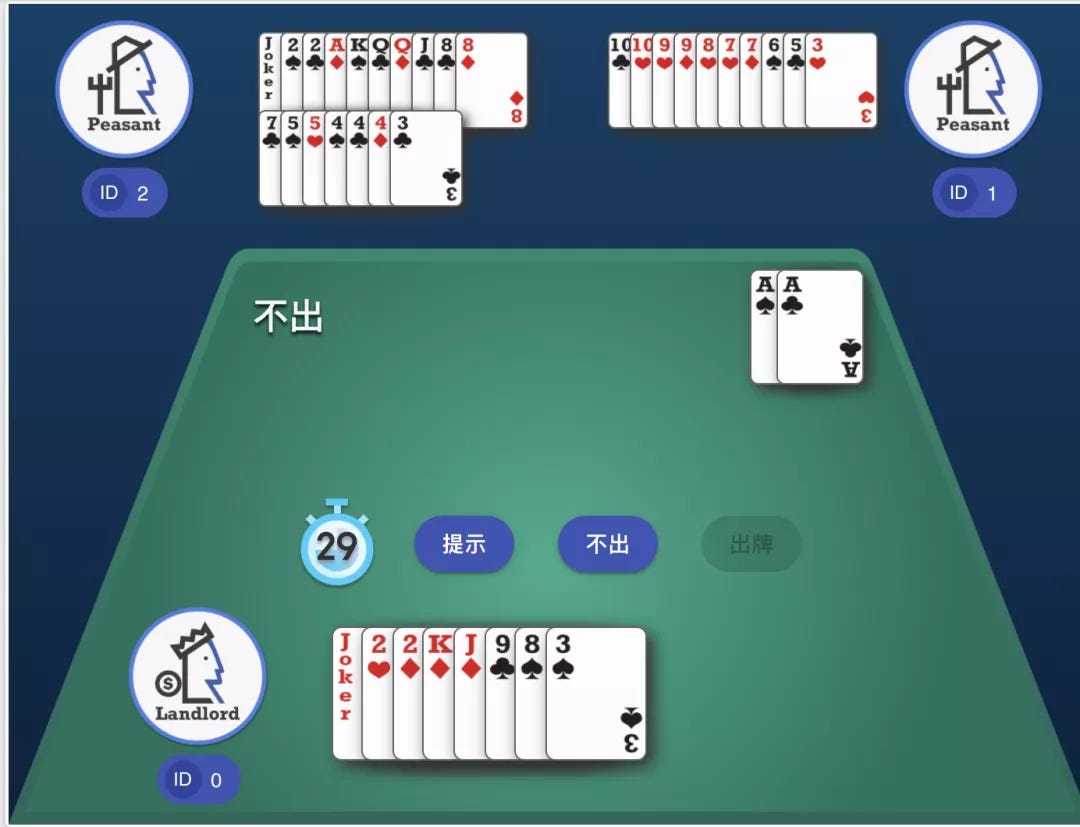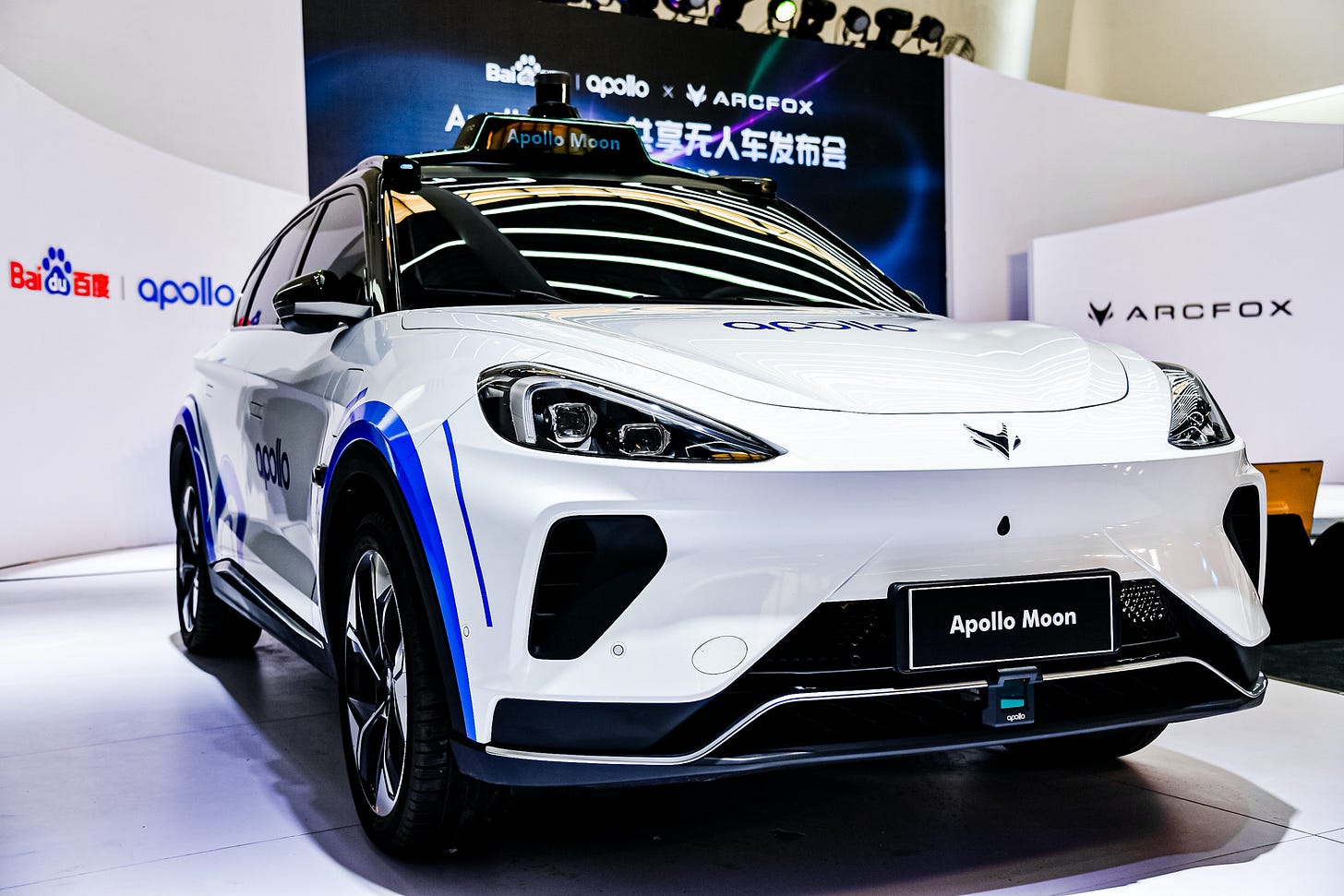AI Plays Dou Dizhu; ImageNet of Graph ML; Baidu's Budget Robotaxi
China’s AI news in the week of June 14, 2021
Please subscribe here to support Recode China AI.
TikTok’s Chinese rival Kuaishou develops an AI to play Dou Dizhu
Kuaishou, a Chinese video-sharing app developer with almost 300 million DAUs, has recently introduced an AI system that can master Dou Dizhu, maybe the most popular card game in China. Their paper DouZero: Mastering DouDizhu with Self-Play Deep Reinforcement Learning has been accepted in ICLR 2021.
The rule of Dou Dizhu is simple: There will be three players joining one game, each taking 17 cards from a 54-card deck, with the last three cards left. Any player can choose and auction to be the landlord who will be endowed with the last three cards. The landlord wins if they have no cards left while the peasant team wins if either of the peasants has no cards left. The landlord goes first by playing any combinations of cards (solo, pair, triplet, and 10 more combos). The next player can either pass or play the same type of combinations but higher numbers.
DouDizhu is a challenging imperfect information game for AI:
a large action space of 10^4, equivalent to poker;
27, 472 possible card combinations;
competition and collaboration co-exist.
In this work, researchers enhanced traditional Monte-Carlo methods with deep neural networks, action encoding, and parallel actors. Cards for both states and actions are encoded into a 4×15 one-hot matrix. The Q-network of DouZero consists of an LSTM to encode historical moves and six layers of MLP. The network predicts a value for a given state-action pair. Then researchers parallelized DMC with multiple actors with local networks and one learner for global network. Trained in a single server with four GPUs from scratch, DouZero ranked the first in the Botzone leaderboard among 344 AI agents.
Last year, Kuaishou developed a Dou Dizhu mobile game, dubbed ‘Ai You Dou Dizhu(爱游斗地主)’, which has claimed the top spot of the free game category in China’s iOS App Store.
You can play the game with AI here. The code is now available on GitHub.
Winners of 1st OGB-LSC challenge announced
Open Graph Benchmark Large-Scale Challenge (OGB-LSC) is a large-scale graph machine learning competition at KDD Cup, also known as ‘ImageNet in graph ML’. With 500 team participants, the challenge consists of three tracks:
Heterogeneous academic graph MAG240M-LSC;
Knowledge graph WikiKG90M-LSC;
Quantum chemistry dataset PCQM4M-LSC.
The challenge has recently wrapped up with winners announced. Baidu won two first places and a joint team of Dalian University of Technology and Microsoft Research Lab - Asia (MSRA) won another. Baidu’s solution developed on its deep learning framework PaddlePaddle can be found on GitHub.
To the surprise of many, the winning team from Dalian UoT and MSRA used the Transformer model instead of graph neural networks in the PCQM4M-LSC dataset which contains 3,803,453 graphs for molecular property prediction.
In the paper Do Transformers Really Perform Bad for Graph Representation, researchers presented Graphormer to apply the Transformer architecture in the graph. They proposed several techniques to leverage the structural information of graphs into the Transformer model - centrality encoding, spatial encoding, and edge encoding in the attention. Read the paper for more details.
Baidu’s new robotaxi costs ~$75K
Mounted with expensive sensors and high-end chips, L4 robotaxi is long known to be big-budget, but the Chinese tech giant Baidu recently rolled out its new-gen autonomous vehicle that costs close to a passenger vehicle.
In a collaboration with state-owned automaker BAIC Group, Baidu unveiled ‘Apollo Moon’, an Arcfox alpha-T electric SUV equipped with L4 autonomous driving capability (Arcfox is BAIC Group’s new energy vehicle brand). The two will team up and manufacture 1,000 such cars in the next three years for Baidu’s autonomous ride-hailing service Apollo Go.
One selling point of Apollo Moon is its low cost of RMB 480K, which is said to be only one-third of the cost of the average L4 robotaxi. The car has two LiDARs, 13 cameras, five radars, and 12 ultrasonic sensors with a computing power of 800 TOPs. Considering the cars itself is priced at RMB 240K-300K, vehicle to hardware is about 50:50.
Apollo Moon’s debut will be a terrific milestone for commercialization of autonomous ride-hailing services if the car performs as well as Baidu claimed, “a 99.99% success rate of ride-hailing in complex urban cityscapes”.
In early May, Baidu opened fully driverless robotaxi services to the public in Beijing’s Shougang Park. The company has accumulated a total testing mileage of over 12 million kilometers (~7.46 million miles).
Investment news
Chinese AI unicorn SenseTime has resumed plans for its IPO in Hong Kong that could raise up to $2 billion, multiple media reported.
ZVISION Technologies, a Chinese startup providing automotive grade solid-state MEMS LiDAR solution for autonomous driving applications, has raised RMB hundreds of million in a Series B financing round from Intel Capital and Sinovation Ventures.
Airdoc, a Chinese startup providing AI medical solutions, has recently raised a Series D funding from LAV, Lake Bleu Capital, OrbiMed. Founded in 2015, Airdoc developed computer-assisted diagnosis for diabetic retinopathy based on fundus images.




